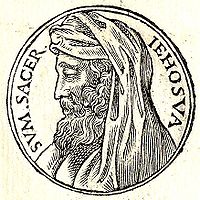Joshua the High Priest

| Part of a series of articles on |
| Priesthood in Judaism |
|---|
| |
|
Priestly covenant |
Joshua the son of Jehozadak (Hebrew: יְהוֹשֻׁוּעַ Yəhōšūaʿ), also spelled Yeshua (Hebrew: יֵשׁוּעַ Yēšūaʿ) was the first High Priest at the reconstruction of the Jewish Temple after the return of the Jews from the Babylonian Captivity (Zechariah 6:9–14 and Ezra 3 in the Bible).
Life
[edit]Joshua son of Jozadak served as High Priest ca. 515–490 BCE in the common List of High Priests of Israel. This dating is based on the period of service at age 25–50 (per Numbers 8) rather than age 30–50 (per Numbers 4).
The biblical text credits Joshua among the leaders that inspired a momentum towards the reconstruction of the temple, in Ezra 5:2. Later 10:18 some of his sons and nephews are found guilty of intermarriage.
In the Book of Zechariah 3:6–10, Zechariah the prophet experiences a vision given to him by an angel of the Lord in which the restoration and cleansing of Joshua's priestly duties are affirmed. Included in the visions were requirements in which Joshua was expected to uphold. These included: (1) walk in the ways of God, (2) keeping the requirements (the law), (3) ruling God's house, (4) take charge of His courts; by fulfilling these duties, the angel granted access to the inner temple to Joshua and his fellow priest. The vision also functioned to purify Joshua and to sanctify him for the preparations of his priestly duties.
He also appears in the Book of Haggai (chapters 1, 2.
The name Joshua is of the same origin as the name Jesus, and Joshua the High Priest is interpreted by Christians to be a foreshadowing of Jesus.
Tomb
[edit]In 1825, the traditional tomb of Joshua was reported to have been found at "one hour's distance from Baghdad."[1]
Patrilineal ancestry
[edit]As per 1 Chronicles chapter 5
| Patrilineal descent |
|---|
Notes and references
[edit]- ^ United Foreign Missionary Society (1825). American missionary register. J. & J. Harper. p. 280. Retrieved 4 October 2010.
External links
[edit]- Pictures of tomb of Joshua the High Priest in Iraq, and Courtyard, by Kobi Arami
